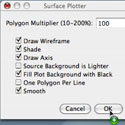Richard J. Holmes and Nicholas J. Goddard
School of Chemical Engineering and Analytical Science (SCEAS),The University of Manchester, Manchester, UK
Why is this useful?
A number of journals (including Lab on a Chip) provide space to upload image and movie data alongside publications on the web. However, the print publication must also contain sufficient illustrations to facilitate the understanding of the content without reference to such files. This tip demonstrates the use of a low cost image analysis system which may be used to facilitate data presentation of poor quality video images for use in paper-based publications. This is especially important in the field of miniaturisation and microfluidics, where video data is often the most convenient format (sometimes the only format) in which to record results.
What do I need?
This work was conducted using an Apple iBook G4 1.42 MHz laptop running OSX Tiger 10.4.8. Additional software is listed below. Links to external websites with these resources are provided.
- Quicktime Pro, the £20 ($30) upgrade from Quicktime standard facilitates rudimentary video editing, single frame extraction, multiple frame sequence extraction and basic post-processing functions such as the ability to vary the playback speed.
- Graphics Converter X, a £20 ($30) shareware application from Lemkesoft offers a multitude of image processing functions and facilitates post-processing of image and movie data to a variety of formats.
- ImageJ, a free (open source) java application offers calibrated measurements functions, windowing, colour processing, edge detection and surface plot functions alongside many others.
What do I do?
The procedure described here uses a microfluidic system developed in-house, and demonstrating hydrodynamic flow of a fluorescent labelled microsphere along a 30 mm channel (500 µm x 500 µm). Illumination was provided using a DPSS laser emitting at 473 nm (laser 2000, Kettering, UK) with an integrated beam expander.
1. Video data can be initially captured as a video file (avi, mov, mp4, etc) with Quicktime Pro being used to edit the video file to a manageable size by removing extraneous frames. Once the required file is prepared, it is then used to export a sequence of frames as JPEG images.
2. The JPEG images can then be imported into Graphics Converter X cropping the region of interest from each frame, allowing for the preparation of individual JPEG files at specific time intervals. Figure 1 shows an example image.
3. After each image is processed as above, a montage of these frames can be created in Graphics Converter X to illustrate the migration of the fluorescent bead as a function of time.
White space can used to space and easily identify the specific “snap-shot” images in the compiled file (Figure 2). However, a black fill tool should be applied to this white background to prevent the data being swamped by the background after processing. The image should be exported as an uncompressed JPEG with 8-bit (256 grays) resolution, corresponding to the internal scale required for ImageJ.
4. The montage JPEG is imported into ImageJ for processing, where the images shown in Figures 1 and 2 are converted to surface plots with the Z axis representing pixel intensity of the image.
Figure 3 illustrates the surface plot of a single frame, as seen in Figure 1, with Figure 4 illustrating the settings options defined in ImageJ.
5. The surface plot of the white space corrected Figure 2 can be seen in Figure 5, illustrating the migration over time of a fluorescently labelled microsphere under hydrodynamic flow conditions.
It can easily be seen in the figures that data represented in this way significantly improves the quality of the output in terms of usability. It should be noted that the trade-off with this technique is in terms of its limited numerical value due to the conversion and compression across file formats and the subsequent loss of data, especially since one of the major limiting factors is the initial quality and resolution of the images obtained. As such, care should be taken when converting data files and ideally, quantitative data should be extracted from uncompressed files only, so as to maintain integrity.
What else should I know?
Ideally, video files should be recorded using high-speed, high frame rate equipment, thereby facilitating discrimination between events on the microsecond scale, thereby improving resolution and reducing the potential for streaking effects.
However, by careful use of a few relatively easy techniques, low quality AVI movie files (hampered by camera resolution, magnification factors and illumination / contrast issues, all of which are prevalent in microfluidics research), which would not usually stand up as results in a major publication may be utilised to their fullest potential, and the small white dot of a few pixels in figure 1 representing the fluorescent bead, becomes a distinct peak, easily distinguished from the background signal.
Whilst this work has been conducted using an Apple Macintosh, it should be noted that similar applications are available for computer systems running Windows and Linux. Additionally, the system mentioned is far more versatile than the single application shown in this tip. The range of functions for such low cost software makes this an essential component in the arsenal of any microfluidics researcher.















